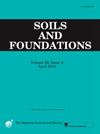从实验室研究到现场应用的污染土壤固化脱水综合修复技术
IF 3.3
2区 工程技术
Q2 ENGINEERING, GEOLOGICAL
引用次数: 0
摘要
由于难以有效控制混合均匀性,重金属污染土壤的固化稳定性往往达不到预期的质量。优化搅拌设备和施工工艺是提高搅拌均匀性的常用方法。但优化搅拌设备成本高,现场适用性有限,提高均匀性效果有限。为了解决这一问题,提出了一种固化/稳定-真空复合脱水技术(SSVD),即提高水胶比,使黏合剂与重金属污染土壤混合均匀,然后立即真空脱水。通过实验室实验和试点项目对其有效性进行了探讨。由于锌是众所周知的降低抗压强度和胶结速度的因素,因此对锌污染土壤进行了研究。研究结果表明,真空脱水在田间凝固硬化初始12 h内成功地去除了固化土中的水分,表明增加水分掺入以提高混合和易性是可行的。此外,它可以增强微观结构,防止污染物的迁移,并通过阳离子交换从凝固体中提取重金属。养护28 d后,室内试验表明,脱水后强度增加1.9 ~ 4.1倍,渗透率降低1.7 ~ 17.8倍。在野外,这些值分别增加1.8倍和减少1.7倍。在实验室脱水后,Zn2+的扩散率也下降了2.0倍。显微组织分析表明,真空脱水显著降低了固化基体的孔隙率,提高了固化基体的完整性。该技术具有较好的和易性和均匀性、较强的致密性和荚膜性、较少的污染物滞留和粘结剂消耗等优点,不仅在固化/稳定修复中具有应用潜力,而且在软土地基改善中也具有应用潜力。本文章由计算机程序翻译,如有差异,请以英文原文为准。
Integrated remediation through solidification and dewatering of contaminated soil from laboratory investigation to in-situ application
Solidification/stabilization of heavy metal contaminated soils often falls short of achieving the desired quality due to challenges in effectively controlling mixing uniformity. Optimization of mixing equipment and construction technology is a common way to improve mixing uniformity. However, optimizing mixing equipment has high cost, limited site applicability and limited effect on improving uniformity. To solve the problem, a combined solidification/stabilization - vacuum dewatering technique (SSVD) was proposed, which is to increase the water to binder ratio to make the binder and heavy metal contaminated soils mixed evenly and then immediately vacuum dewatering. Its efficiency was explored through both laboratory experiments and a pilot project. Because zinc is a well-known factor that decreases compressive strength and cementation speed, zinc contaminated soil was studied. The findings indicate that the vacuum dewatering successfully removes water from solidified soils during the initial 12 h of setting and hardening in the field, indicating the feasibility of more water incorporation to raise the mixing workability. Furthermore, it can enhance the microstructure to prevent the migration of pollutant, and extract the heavy metals from the solidified mass by the cation exchanges. After 28 days of curing, laboratory tests showed a 1.9-4.1 times’ increment in strength and a 1.7-17.8 times’ reduction in permeability after dewatering. In the field, these values increase by 1.8 times and decrease by 1.7 times, respectively. The Zn2+ observed diffusivity also decreases by 2.0 times after dewatering in the laboratory. Microstructure analysis reveals that the vacuum dewatering significantly reduces the porosity of the solidified matrix, thereby enhancing its integrity. The proposed technology holds potential for the application not only in the solidification/stabilization remediation but also in the soft ground improvement in term of the better workability and homogeneity, stronger densification and capsulation, and less pollutant retention and binder consumption.
求助全文
通过发布文献求助,成功后即可免费获取论文全文。
去求助
来源期刊

Soils and Foundations
工程技术-地球科学综合
CiteScore
6.40
自引率
8.10%
发文量
99
审稿时长
5 months
期刊介绍:
Soils and Foundations is one of the leading journals in the field of soil mechanics and geotechnical engineering. It is the official journal of the Japanese Geotechnical Society (JGS)., The journal publishes a variety of original research paper, technical reports, technical notes, as well as the state-of-the-art reports upon invitation by the Editor, in the fields of soil and rock mechanics, geotechnical engineering, and environmental geotechnics. Since the publication of Volume 1, No.1 issue in June 1960, Soils and Foundations will celebrate the 60th anniversary in the year of 2020.
Soils and Foundations welcomes theoretical as well as practical work associated with the aforementioned field(s). Case studies that describe the original and interdisciplinary work applicable to geotechnical engineering are particularly encouraged. Discussions to each of the published articles are also welcomed in order to provide an avenue in which opinions of peers may be fed back or exchanged. In providing latest expertise on a specific topic, one issue out of six per year on average was allocated to include selected papers from the International Symposia which were held in Japan as well as overseas.
 求助内容:
求助内容: 应助结果提醒方式:
应助结果提醒方式:


